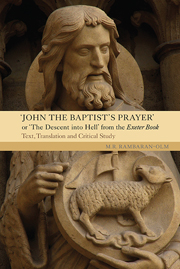 John the Baptist's Prayer 'The Descent into Hell' from the Exeter Book
John the Baptist's Prayer 'The Descent into Hell' from the Exeter Book Book contents
- Frontmatter
- Contents
- Illustrations
- Acknowledgements
- Abbreviations
- Dedication
- Introduction
- 1 Palaeography, Codicology and Language
- 2 The Descensus Motif
- 3 Literary Analysis
- 4 Selected Comparative Studies and Analogous Literature
- Afterword
- Text and Translation
- Commentary
- Appendix 1 The Doctrine of the Descensus according to Post-Apostolic and Medieval Commentators from the First Century to the End of the Eleventh Century
- Appendix 2 Scriptural References
- Appendix 3 Other Sources and Analogues
- Appendix 4 Transcription and Images of fol. 120r
- Glossary
- Biblioigraphy
- Index
Appendix 4 - Transcription and Images of fol. 120r
Published online by Cambridge University Press: 05 August 2014
- Frontmatter
- Contents
- Illustrations
- Acknowledgements
- Abbreviations
- Dedication
- Introduction
- 1 Palaeography, Codicology and Language
- 2 The Descensus Motif
- 3 Literary Analysis
- 4 Selected Comparative Studies and Analogous Literature
- Afterword
- Text and Translation
- Commentary
- Appendix 1 The Doctrine of the Descensus according to Post-Apostolic and Medieval Commentators from the First Century to the End of the Eleventh Century
- Appendix 2 Scriptural References
- Appendix 3 Other Sources and Analogues
- Appendix 4 Transcription and Images of fol. 120r
- Glossary
- Biblioigraphy
- Index
Summary
NOTE ON THE RECONSTRUCTED FOLIO
Restoration of damaged texts is nothing new in relation to manuscript studies and the prospects of providing new insights into texts can be facilitated through digital reconstruction or restoration, in particular. Some critics maintain reservations about tampering with a text as it has come down to us, and their concern that reconstruction can manipulate and corrupt readings, interpretations and authorial intent is, quite rightly, valid. However, as S. Larratt Keefer claims, if we
consider what greater riches we might have uncovered, had we been provided with a copy of the original scribal version from which the Julius scribe himself [for example] did his work … it seems right that we should also present, together with our scholarly but subjective views on the text, an absolutely honest replica of all physical evidence from the manuscript witness wherein it is found.
I have attempted in the edition to present the text as it was, whilst keeping in mind that its layout mediates between a structure that adheres to the metrical patterns of the Old English poem whilst also providing a familiar orientation to modern readers of poetry. In the case of these digital reconstructions, though, along with scrutinizing the text and the characteristics of Old English poetry like metre and alliteration, I have further analysed the individual folios, closely examining the lacunae and the surrounding areas of texts where gaps exist and basing critical conjectures on internal manuscript evidence.
- Type
- Chapter
- Information
- John the Baptist's Prayer 'The Descent into Hell' from the Exeter BookText, Translation and Critical Study, pp. 202 - 210Publisher: Boydell & BrewerPrint publication year: 2014


